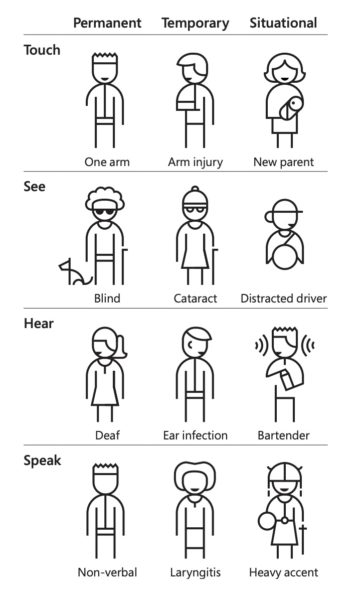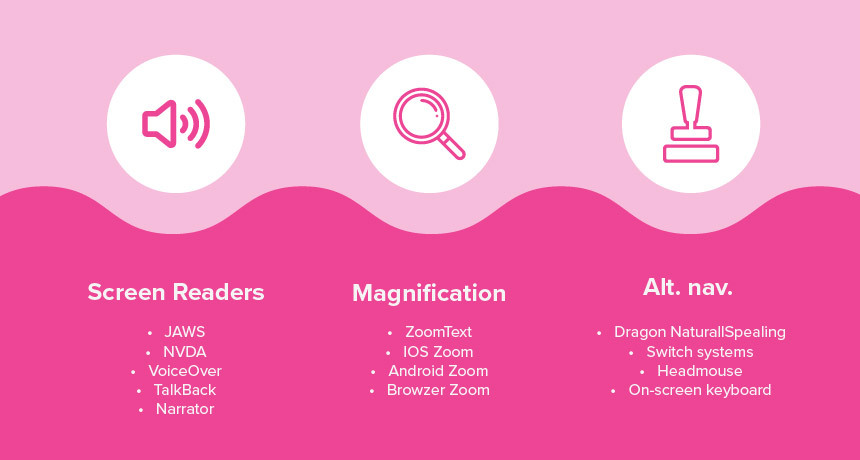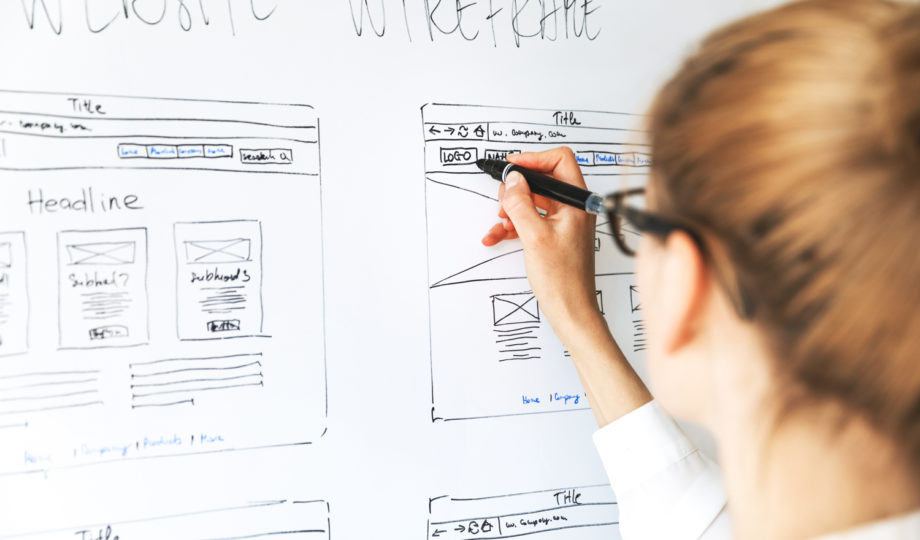Written By: Amy Sullivan
Lately, Outwitly has been prioritizing more inclusive research practices, particularly by engaging in user research with participants who have disabilities and use assistive technology. We’ve been fortunate to collaborate with clients who recognize the importance of including people with disabilities in user research to design experiences that are barrier-free and widely inclusive.
Even though one billion people worldwide, or approximately 15% of the global population, live with some form of disability, according to the World Health Organization, disabled users are often overlooked in mainstream user research and training.
Navigating the landscape of disability language, accessibility, and assistive technology can be intimidating, especially for UX professionals who may not have specific training in these areas. The existing tools and guides are often geared towards those in development and QA roles. This uncertainty can result in the unfortunate outcome of UX professionals avoiding inclusive research altogether due to fear of making mistakes. But the good news is it doesn’t have to be that way!
In the first installment of our blog series on accessible user research practices, we’re delving into:
- Important Terms And Disability Language For UXers
- What UX Research Teams Should Know Before Diving Into Accessibility
- The Role of Assistive Technology in Research Studies
Let’s do this!
Important Terms And Disability Language For UXers
Let’s chat about disability language—it’s a game-changer in how we perceive and include folks with disabilities. Our words can either empower or sideline, so choosing the right ones is key for showing respect and fostering equality. Over time, we’ve shifted from using negative terms to more inclusive language that puts people first.
- Term: First-person language. It’s all about emphasizing the person over their disability, highlighting that someone isn’t defined by their limitations. So, instead of saying “disabled person,” we say “a person with a disability.” It’s a small change that packs a punch, pushing us to see the whole person, not just their disability. This shift aims to break down stereotypes and create a fuller picture of individuals with disabilities.
And hey, steering clear of outdated or offensive terms is just as important. Using language that respects the independence and choices of folks with disabilities helps us build a more inclusive society!
But here’s the thing—preferences can differ. People have their take on what feels right for them; language is a personal preference. So, being a good listener and respecting how someone wants to be addressed is key when discussing their disabilities.
In the end, disability language is important for changing attitudes, nurturing empathy, and building a world where everyone, no matter their abilities, feels valued and part of the conversation. The key is to be confident and comfortable with language and with people. If you use a phrase and someone has a differing preference, make the correction (and any apologies if needed), then continue.
The Role of Personal Bias in Accessibility Work
The reality is that every person has their own lived experience – user researchers included! Because of this, we must do more than just learn from participants with disabilities to represent their views in research properly. Not only is it important to hear from the participants themselves, but researchers need to confront their own biases and disability viewpoints, too. Here are some key terms to help you on this journey:
- Terms: Ableism. Discrimination or prejudice against individuals with disabilities perpetuates stereotypes and marginalizes them based on their abilities. It manifests in various forms, hindering equal opportunities and reinforcing societal barriers. Advocates work towards dismantling ableism to create a more inclusive and accessible world for everyone. Ableism can manifest in various ways, often stemming from discriminatory attitudes and practices that marginalize individuals with disabilities. Here are some examples of ableism:
-
- Inaccessible Infrastructure: (as mentioned above!) When public spaces, buildings, or transportation systems lack accommodations such as ramps, elevators, or accessible bathrooms, it creates barriers for people with mobility challenges.
-
- Online Accessibility Issues: Websites, software, or online platforms that aren’t designed with accessibility features can exclude individuals with disabilities from participating fully in the digital sphere.
-
-
- For example, researchers may look upon participants as “amazing” when they adapt everyday activities and subsequently miss key findings that should have been the actual research focus.
-
Suppose researchers or their teams view disability as a lesser human condition. In that case, there’s a high risk that researchers underestimate the insights gained from research involving individuals with disabilities or give the findings a lower priority. Recognizing and prioritizing the significance of inclusive research findings is crucial – we must consider them equally as valuable as insights from studies that lack inclusivity. This idea is known as the curb-cut effect.
- Term: The Curb Cut Effect. The curb-cut effect refers to the phenomenon where accommodations or improvements made for a specific group, often individuals with disabilities, benefit a much broader population. The term originated from installing curb cuts and sloped ramps at street corners designed to assist people using wheelchairs or other mobility aids. While initially implemented for the convenience of wheelchair users, curb cuts also proved advantageous for parents with strollers, travellers with luggage, and anyone else who benefited from easier navigation of street corners.
Recognizing disability as a form of diversity can instill confidence in prioritizing accessible design for the benefit of all users.
Expanding your perspective on disability as a researcher
Before involving participants with disabilities, researchers should examine their perspectives. We’ve compiled the following list to help you expand your perspective on disability. Take your time in watching the following videos before diving into research.
- DC Government’s Sensitivity Training or Apple’s Sady
- The Greatest Accessibility commercials
- Stella Young’s TED Talk, “I’m not your inspiration, thank you very much.”
- Stella Young’s talk is especially fun to watch. She challenges the common perception of people with disabilities as inspirational solely for their ability to navigate their lives. Stella (hilariously) highlights the tendency to romanticize disability overly, emphasizing that individuals with disabilities are not here to inspire others just by existing. She critiques the societal habit of viewing disability through the lens of overcoming adversity and urges a shift toward recognizing disabled individuals as ordinary people living their lives. Stella’s talk encourages audiences to reevaluate their perspectives on disability and appreciate human experiences’ of diversity beyond stereotypes and inspirational narratives.
These types of resources have informed some of the biggest players in the technology space, like Microsoft! Their design team are notable leaders for those who want to learn more about disabilities, including this great visual about the three categories of disabilities we can consider (just like we do when creating personas in UX design!)
Below, you’ll see three categories that help illustrate different perspectives: permanent, temporary, and situational disabilities. As designers and researchers, it’s important to consider how these perspectives will affect how your user or customer interacts with what you create.
From Microsoft’s Inclusive101 Guidebook
- Permanent disabilities refer to long-term impairments that individuals live with consistently, such as vision or mobility challenges. Features like screen readers, voice commands, and customizable interfaces in operating systems and software cater to users with permanent disabilities.
- Temporary disabilities arise from short-term conditions like injuries or surgeries. It’s important to accommodate these users by providing features like dictation tools, ergonomic adjustments, and adaptable interfaces that can be personalized to meet temporary accessibility needs.
- Situational disabilities result from specific circumstances, impacting individuals differently based on context. For instance, a loud environment may create a situational disability for someone who relies on auditory cues. We can address situational disabilities through features like closed captions, subtitles, and speech-to-text functionalities.
What UX Research Teams Should Know Before Diving Into Accessibility
“Accessibility is one topic that sits under the umbrella of inclusive design; ensuring that the things we design are accessible to people regardless of disability. It’s about building a door that can be opened by anyone and lets everyone in.” – Maya Alvarado
Accessibility is a longstanding concept. With each new technological innovation, individuals design tools to accommodate various abilities. Notably, innovations often stem from designing for disabilities, like the iPhone’s multitouch gestures created to alleviate repetitive wrist injuries. The Web Content Accessibility Guidelines (WCAG), established web standards, have been around for over 20 years since their publication in 1999. There’s a wealth of information to delve into before a UXR team embarks on their work, and the key is knowing where to find it – fortunately, we’ve got you covered.
-
- Term: A11y research:
- Derived from the word “accessibility” by taking the first and last letters (“A” and “y”) and placing the number “11” in between. This shorthand is commonly used in the technology and web development communities.
- A11y research refers to research activities specifically focused on accessibility. Accessibility research aims to understand, evaluate, and improve the usability of products, services, or environments for individuals with disabilities. This can include studying the effectiveness of assistive technologies, evaluating the inclusivity of digital platforms, and exploring design considerations to ensure that products and services are usable by a diverse range of users, including those with disabilities. The goal of A11y research is to inform the creation of more accessible and inclusive solutions, ultimately enhancing the user experience for everyone, regardless of their abilities or disabilities.
- Term: A11y research:
- Term/tool: WCAG:
- The Web Content Accessibility Guidelines are part of a series of web accessibility guidelines published by the Web Accessibility Initiative of the World Wide Web Consortium, the main international standards organization for the Internet.
- While standards are crucial in digital accessibility work, they can be complex for beginners. To facilitate understanding, the W3C-WAI website offers a wealth of carefully curated content. Start with the “Accessibility Fundamentals” menu to set the tone for the guidelines, and explore the informational definition and summary pages under the “Standards/Guidelines” menu.
Supplementary plain language checklists, like those from The A11y Project, can aid comprehension. Still, it’s essential to refer to the official standards directly to ensure accurate and complete interpretation and implementation.
The Role of Assistive Technology in Research Studies
In the realm of UX research involving disabled participants, the use of assistive technology becomes a notable aspect. Assistive technology refers to tools and techniques employed by individuals with disabilities for computer-based tasks. Understanding these devices and techniques is crucial for deciphering the observed interactions during a research study.
Common assistive technologies include:
- Screen Reader (also written as Screenreader or Screen-reader): A screen reader is a type of assistive technology that outputs on-screen text using text-to-speech, primarily used by those who are blind.
- Screen Magnifier (also written as Screen Magnification Software or Software Magnifier): A screen magnifier is a type of assistive technology that magnifies the contents of a screen, increases colour contrast, and performs other visual modifications to the screen, making it easier to see for people who have low vision.
- Alternative Navigation: Alternative navigation is any type of assistive technology that replaces a standard keyboard or mouse. It’s primarily used by those with physical mobility challenges.
For more, take a deep dive into this awesome glossary developed by Fable, including the more in-depth definition, related terms, and related reading.
In wrapping up, our exploration of Disability, Accessibility, and Assistive Technology in User Research highlights a crucial commitment. Accessibility is more than a feature; it’s the backbone of responsible and effective design. This means designing for accessibility isn’t just a choice; it’s something we owe to each other.
Let’s carry these insights with us, encouraging a continual learning journey and a dedication to creating a digital world that genuinely accommodates and values every user. Start by advocating for inclusivity in your daily work and include the real experts, in this case – those with disabilities who use assistive technology – in your research.
Here’s a complete list of all those resources we mentioned and more to kickstart your studies:
Resources From The Blog Above
- World Report on Disability 2011 – WHO
- Disability Sensitivity Training
- Apply – Accessibility – Sady
- Apple – The Greatest
- I’m not your inspiration, thank you very much, by Stella Young at TEDxSydney, 2014
- Microsoft’s Inclusive 101 Guidebook
- Building accessibility research practices by Maya Alvarado of Booking.com
- Fable’s Assistive Technology Glossary
More Goodies to Help You on Your Way
Journals:
Academic Conferences:
Industry Conferences:
Webinar Series:
Podcast episodes:
- Awkward Silences Podcast
- The Accessibility Revolution: How Technology is Empowering Everyone
- Incorporating Accessibility into UX Education from the Beginning
Mailing Lists:
Websites Resources:
Blogs:
- Getting Started With Accessibility UX Research – Assistiv Labs
- Accessibility testing: tips and best practices from industry leaders – UserTesting.com
- Accessibility for designer: where do I start? – Stephanie Walter
Books:
- “Demystifying Disability: What to Know, What to Say, and How to be an Ally” by Emily Ladau
- “Mismatch: How Inclusion Shapes Design” by Kat Holmes
- “Design for Real Life” by Eric Meyer and Sara Wachter-Boettcher
- “A Web for Everyone: Designing Accessible User Experiences” by Sarah Horton and Whitney Quesenbery
- “Inclusive Design Patterns: Coding Accessibility Into Web Design” by Heydon Pickering
- “Digital Outcasts: Moving Technology Forward without Leaving People Behind” by Kel Smith
- “Accessibility for Everyone” by Laura Kalbag
- “Ensuring Digital Accessibility through Process and Policy” by Jonathan Lazar, Daniel Goldstein, and Anne Taylor






